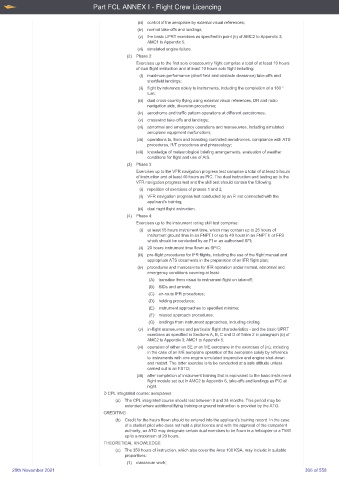Page 306 - UK Aircrew Regulations (Consolidated) 201121
P. 306
Part FCL ANNEX I - Flight Crew Licencing
(iii) control of the aeroplane by external visual references;
(iv) normal take-offs and landings;
(v) the basic UPRT exercises as specified in point (b) of AMC2 to Appendix 3;
AMC1 to Appendix 5;
(vi) simulated engine failure.
(2) Phase 2:
Exercises up to the first solo crosscountry flight comprise a total of at least 10 hours
of dual flight instruction and at least 10 hours solo flight including:
(i) maximum performance (short field and obstacle clearance) take-offs and
shortfield landings;
(ii) flight by reference solely to instruments, including the completion of a 180 °
turn;
(iii) dual cross-country flying using external visual references, DR and radio
navigation aids, diversion procedures;
(iv) aerodrome and traffic pattern operations at different aerodromes;
(v) crosswind take-offs and landings;
(vi) abnormal and emergency operations and manoeuvres, including simulated
aeroplane equipment malfunctions;
(vii) operations to, from and transiting controlled aerodromes, compliance with ATS
procedures, R/T procedures and phraseology;
(viii) knowledge of meteorological briefing arrangements, evaluation of weather
conditions for flight and use of AIS.
(3) Phase 3:
Exercises up to the VFR navigation progress test comprise a total of at least 5 hours
of instruction and at least 40 hours as PIC. The dual instruction and testing up to the
VFR navigation progress test and the skill test should contain the following:
(i) repetition of exercises of phases 1 and 2;
(ii) VFR navigation progress test conducted by an FI not connected with the
applicant’s training;
(iii) dual night flight instruction.
(4) Phase 4:
Exercises up to the instrument rating skill test comprise:
(i) at least 55 hours instrument time, which may contain up to 25 hours of
instrument ground time in an FNPT I or up to 40 hours in an FNPT II or FFS
which should be conducted by an FI or an authorised SFI;
(ii) 20 hours instrument time flown as SPIC;
(iii) pre-flight procedures for IFR flights, including the use of the flight manual and
appropriate ATS documents in the preparation of an IFR flight plan;
(iv) procedures and manoeuvres for IFR operation under normal, abnormal and
emergency conditions covering at least:
(A) transition from visual to instrument flight on take-off;
(B) SIDs and arrivals;
(C) en-route IFR procedures;
(D) holding procedures;
(E) instrument approaches to specified minima;
(F) missed approach procedures;
(G) landings from instrument approaches, including circling.
(v) in-flight manoeuvres and particular flight characteristics - and the basic UPRT
exercises as specified in Sections A, B, C and D of Table 2 in paragraph (b) of
AMC2 to Appendix 3; AMC1 to Appendix 5;
(vi) operation of either an SE or an ME aeroplane in the exercises of (iv), including
in the case of an ME aeroplane operation of the aeroplane solely by reference
to instruments with one engine simulated inoperative and engine shut-down
and restart. The latter exercise is to be conducted at a safe altitude unless
carried out in an FSTD;
(vii) after completion of instrument training that is equivalent to the basic instrument
flight module set out in AMC2 to Appendix 6, take-offs and landings as PIC at
night.
D CPL integrated course: aeroplanes
(a) The CPL integrated course should last between 9 and 24 months. This period may be
extended where additional flying training or ground instruction is provided by the ATO.
CREDITING
(b) Credit for the hours flown should be entered into the applicant’s training record. In the case
of a student pilot who does not hold a pilot licence and with the approval of the competent
authority, an ATO may designate certain dual exercises to be flown in a helicopter or a TMG
up to a maximum of 20 hours.
THEORETICAL KNOWLEDGE
(c) The 350 hours of instruction, which also cover the Area 100 KSA, may include in suitable
proportions:
(1) classroom work;
20th November 2021 306 of 558

